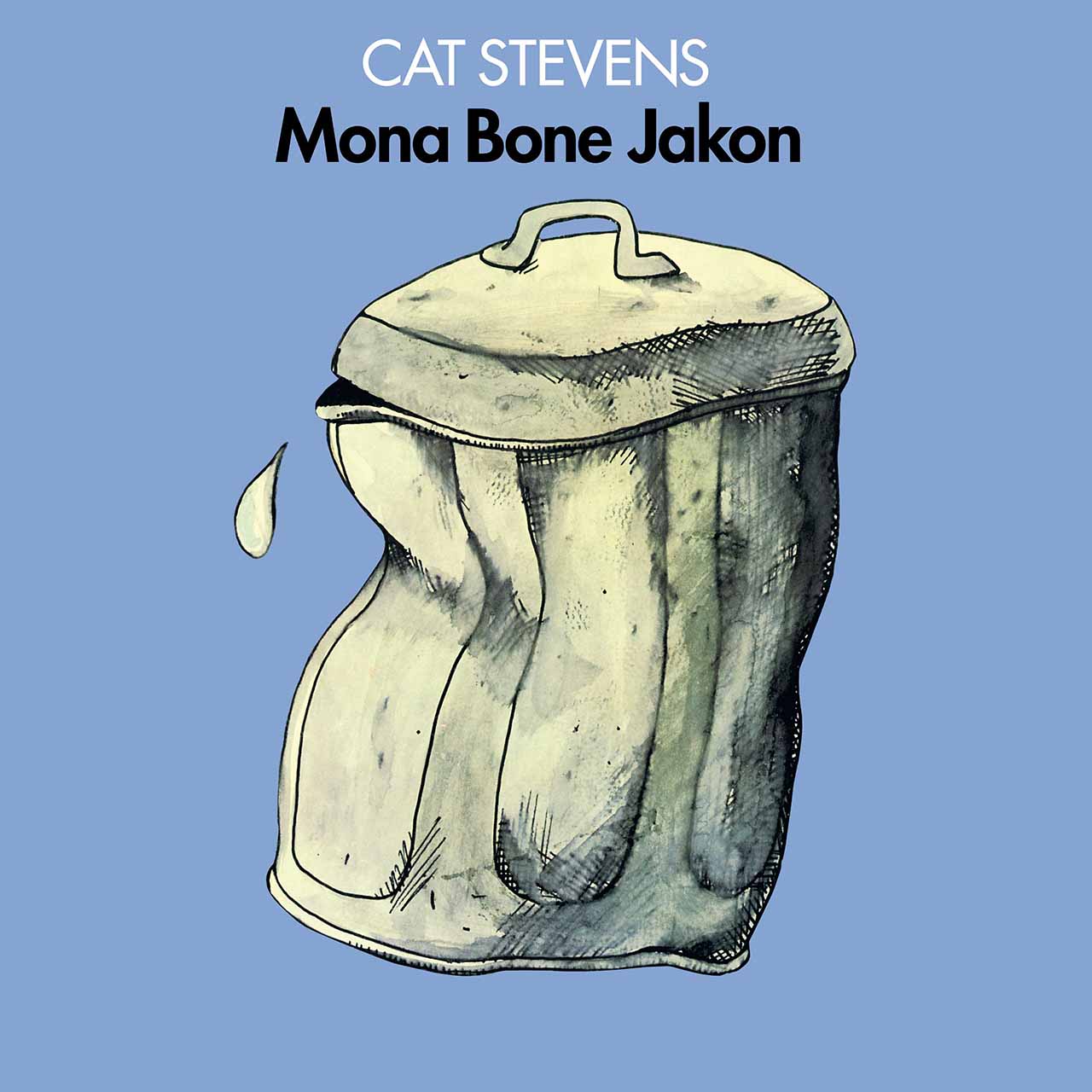Mona Bone Jakon, the third album by Cat Stevens, represented a seismic change in artistic direction and put the singer-songwriter on the road towards being one of the most successful artists of the 1970s. Back in 1967, the 19-year-old Stevens shot to fame in the UK with the orchestrated baroque pop of UK Top 10 hits “Matthew And Son” and “I’m Gonna Get Me A Gun.” By the time Mona Bone Jakon emerged, the strutting dandy of three years previously was tousled and bearded with a guitar around his neck and a crop of sensitive, introspective songs. But this wasn’t merely a bid to ride the early ’70s wave of singer-songwriters, Mona Bone Jakon came from a deeper place – a genuine urge on Stevens’ part to communicate his thoughts, hopes and fears. So, what had happened in the intervening years to bring about such a drastic change?
As 1968 dawned, the still-teenage Stevens was in a bad way. His last few singles had flopped – unthinkable in the fast-moving, brutal world of ’60s pop. What’s more, he was struggling with the demands of the industry. Stevens was utterly exhausted, often playing multiple shows a day, drinking and smoking to excess. He also had developed a persistent cough. Stevens was friends with the popular vocal duo Paul & Barry Ryan, the twin sons of Marion Ryan, a popular UK singer in the 1950s. One day, Marion took a look at the increasingly sickly young singer and arranged for Stevens to be seen at Harley Street Clinic, London.
Listen to the deluxe edition of the Cat Stevens album Mona Bone Jakon now.
Stevens was diagnosed with an advanced form of pleurisy, also known as tuberculosis, and was sent to King Edward VII hospital in the Sussex countryside, where he spent three months. His period of convalescence initially proved frustrating, but when Paul Ryan sent him a book called The Secret Path by Paul Brunton, it brought about a change in Stevens’ attitude. He told Circus magazine in 1971, “It was just what I needed. I read that book once and thought about it and I used it to meditate. There was nowhere that was quiet enough in the hospital. I had to creep out and there was this cow shed with a couch in it. I used to go in there and lock the door, then sit down and think. It was completely silent and that is where it came to me. It just happened. You reach that moment and you see it and say ‘of course!’ Then everything sprung from there like light.”
The following months were transformative, putting Stevens on a path of self-discovery. In an interview with Rock magazine in 1971, Stevens reflected on the time, “The greatest thing that happened to me was when I realized I wasn’t the only person in the world. The thing I really wanted to do was to understand people and to put myself second. Then I realized that the only way to do that was to understand myself… then other people would understand me.” Decades later, Stevens told MOJO that “this disease… was a kind of godsend in a way for me. That period was my blossoming into who I wanted to be.”
Stevens had a small record player during his hospital stay and rediscovered the music of Bach, which he later credited with inspiring a more direct approach to his own songwriting. A purple patch of creativity ensued, which continued when Stevens left the hospital to spend nine months recovering in a flat above his parents’ café in London’s West End. Stevens immersed himself in learning about spirituality, studying Buddhism, Hinduism, Zen, Tao, numerology, and astrology in a mind-expanding period of seclusion, while taking up yoga and becoming vegetarian. His interests were reflected in the songs he was writing, roughly 40 in total over the year, the majority of which would feature on his next three solo albums – Mona Bone Jakon, Tea For The Tillerman, and Teaser And The Firecat.
Cat Stevens signs with Island Records
Stevens made his first appearance post-recovery supporting The Who at the Roundhouse, North London in February 1969. He hired an agent, Barry Krost, who secured an audition with Chris Blackwell of Island Records. Blackwell was left cold by Stevens’ pop hits and reluctant to hear his new material. He finally relented and when Stevens played “Father And Son” (later released on Tea For The Tillerman), Blackwell was floored. The label boss later told Interview magazine, “I became very excited to sign him because I thought his work was so incredible. But he said he was signed to Decca. So I said, ‘Well, what’s your deal with Decca?’ He told me, and I said, ‘I think I can match that.’”
With Island, Stevens was given control over his music for the first time. He chose producer Paul Samwell-Smith, formerly of The Yardbirds, on the strength of his work on Renaissance’s self-titled 1969 debut. Samwell-Smith introduced him to guitarist Alun Davies, formerly of Sweet Thursday, reasoning that Davies’ finger-picking style would complement Stevens’ rhythmic strumming style. The producer’s hunch proved correct, and the duo hit upon a warm acoustic sound.
Recording and reception of the album
Recorded in January and February 1970 in London, Mona Bone Jakon was the perfect introduction to the new Cat Stevens. Songs such as the rapturous, gospel-infused “I Think I See The Light” and “I Wish, I Wish”, with its country groove reminiscent of The Band’s glorious self-titled album, saw the young singer-songwriter tackle big themes – his spiritual quest, identity, morality – while serving up infectious melodies. Meanwhile, “Time” was an exploration of existential doubt set to an Eastern-influenced arrangement that added a psychedelic dimension to the album.
Stevens’ time in recovery is referred to most explicitly with “Trouble,” one of the album’s most affecting songs. There is a sense of yearning for a new start, that he has learned his lesson: “Trouble move from me/I have paid my debt, now won’t you leave me in my misery.” It is also made apparent just how serious Stevens’ illness was (“I can see death’s disguise hanging on me”). Still, despite the inspiration coming from such a specific experience, “Trouble” proved to be one of Stevens’ most beloved songs, with notable covers by Elliott Smith and Kirstin Hersh. The song also provided Hal Ashby’s 1971 black comedy Harold & Maude with one of its most moving scenes. The bucolic “Katmandu” was the flip – another song about Stevens’ convalescence but this time hopeful, looking forward to future adventure.
Meanwhile, “Pop Star” was another indicator of change, its sarcastic lyrics leaving the audience in no doubt of Stevens’ feelings about the trappings of fame – especially considering that it’s a ragged acoustic track featuring Stevens’ vocals at their most grizzled (see also, the title track).
Stevens takes on more traditional singer-songwriter fare with “Lady d’Arbanville,” which begins as a delicate madrigal steeped in English romantic poetry. Stevens sounds like every bit the wounded bard, singing of estranged love before a Balkan rhythm takes hold, pointing to his Greek roots. It was written a short while after Stevens and his girlfriend, the actress Patti D’Arbanville, parted ways and she returned to New York. D’Arbanville later said that when Stevens called her to play her the song, “I cried when I heard it, because that’s when I knew it was over for good.” Released as a single, it reached No. 8 in the UK chart, an early sign of the success that Stevens’ new direction would bring him.
Still, Mona Bone Jakon was not an immediate success, only reaching No. 63 on the UK album chart (though it would eventually sell over a million copies worldwide). Most importantly, the album drew a line under his past career and established Stevens as an artist with a unique sound and worldview. The rest of the world would catch up with him soon enough…
Listen to the deluxe edition of the Cat Stevens album Mona Bone Jakon now.



